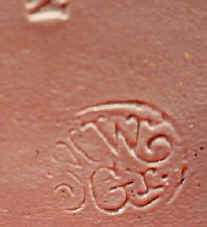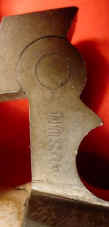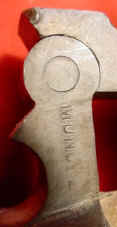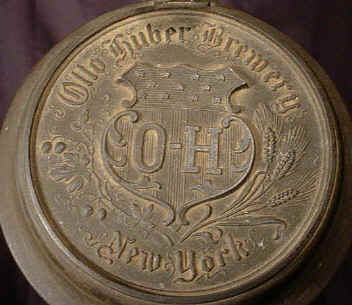
 Stein Collectors International
Stein Collectors International
Featured Stein: November 2005

 Stein Collectors International
Stein Collectors International
Featured Stein: November 2005
~ The Otto Huber Goldenrod Beer Stein ~
An American Brewery Stein
by Walter B. Vogdes
Here we see a stein manufactured in Germany by the venerable Westerwald
stoneware firm of Merkelbach & Wick, circa 1900, for an American brewery.
The founder of the Otto Huber Brewery was a German immigrant who worked in the
brewing industry in Brooklyn in the 1860s, establishing his own plant late in
that decade. Huber's brewery was to grow into one of the largest and most
productive breweries in the borough. The plant seems to have adopted the name
shown on the lid of this stein - Otto Huber Brewery - following his death in
1889 when his sons took over the business. The family continued to operate it
until 1920 when it was sold to a gentleman named Hittleman who renamed the
brewery after himself. Hittleman produced "near beer" until the end of
Prohibition, and in 1934 changed the name to Hittleman-Goldenrod Brewery.
Goldenrod Beer was a traditional name dating to Huber's early years, hence the
goldenrod adorning the face of this stein. A tray produced in the mid-30s shows
the factory, proclaiming it as "The Home of Goldenrod Beer, Porter,
Ale."
The stein's pedigree is well documented. The familiar
trademark of Merkelbach & Wick is incised in the base (a stylized
"M&W" above a "Gr" signifying Grenzhausen). The nice
relief pewter lid which ties the stein together was made by Martin Pauson of
Munich, as we can see on opposite sides of the pewter shank. Pauson operated a
finishing shop in Munich, well known for his fine pewter work, and it is
entirely feasible that he decorated the body of this stein as well.



The lid on this stein bears a large relief shield displaying the stars
and stripes. "Otto Huber Brewery" appears above the shield, "New
York" below, and the shield is surrounded by hops vines and sheaves of
grain, these latter being typical motifs for the brewer's art.
One interesting thing about this nice lid which easily escapes attention is the
use of standard heraldic color-coding for the colors of the fields in the
shield. When coats of arms appeared without color, the heralds devised a system
of color-coding. Vertical lines were used for red, and horizontal lines indicate
blue. The lid is seen in it natural state below left, with a "digitally
colorized" version to the right.


For those who want to know the rest of the heraldic color conventions, a plain field indicates silver or white (which have become somewhat ambiguous over the centuries), a field containing evenly spaced dots represents gold, a cross-hatched field (a la a screen door) indicates black, while diagonal lines are used to indicate green and purple (upper left to lower right, and upper right to lower left, respectively).